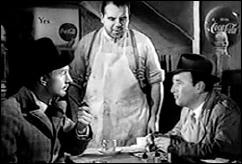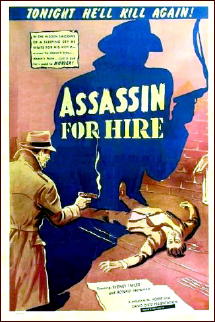Mon 28 Nov 2011
ASSASSIN FOR HIRE. Anglo-Amalgamated Films, UK, 1951. Sydney Tafler, Ronald Howard, Katharine Blake, John Hewer, June Rodney. Director: Michael McCarthy.

Since this is an obscure British film of some 60 years in age, other than, of course, Ronald Howard, none of the names above meant anything before I watched this movie. Even afterward — even while noting that all of the participants were professionals through and through — I may be hard pressed to remember them the next time I come across them. (Ronald Howard was the star of the 1950s Sherlock Holmes series that made its way the US back then, so anyone of a certain age, as I am, should pick him out right away.)
He plays a Scotland Yard inspector in Assassin for Hire, an officious type who declares at the beginning that if the criminals don’t play by the rules, why should he? His eye in particular is on Antonio Riccardi (Sydney Tafler) whom he suspects is a hitman for anyone who cares to hire him. He is very good at what he does, including making sure that he has an ironclad alibi for every one of the extracurricular job he does.
Every criminal has a weakness, believes Inspector Carson, and Riccadi, by day a dealer in rare stamps, may have his in his brother, a classical violinist whose career he keeps under an iron thumb. Well, there’s no “may have†about it. The question is, how might the inspector take advantage of it?
This is a short film, just over an hour long, and it would have been ideal for an episode of the Alfred Hitchcock Hour on TV, say, with several twists along a way, mostly toward the ending. I will not tell you how many twists, for if I were to do so, you’d be counting along as you’re watching. (Of course I could tell you that there were three, say, with the third one being that there is no third one.)
There’s nothing here for any of the players to have built a career on, but it’s competently done, and if you were to find a copy on DVD, I don’t think you’ll begrudge the short time it would take you to watch it.

November 29th, 2011 at 12:44 pm
You’re right about this being something in the ALFRED HITCHCOCK PRESENTS style. By the way, SEASON 5 (maybe the best season) of ALFRED HITCHCOCK PRESENTS comes out next month.
November 29th, 2011 at 12:59 pm
For the most part, I don’t find the 30 minute Hitchcock shows nearly as enjoyable as those done on the ALFRED HITCHCOCK HOUR, but at the rate they’re going, it will be a long long time before they’re officially released.
After next month’s Season Five, only two more seasons of the 30 minute series to go…
November 29th, 2011 at 4:34 pm
The just-over-an-hour running time identifies this film as a “Quota Quickie”.
During the ’30s and ’40s, American movies so dominated the world marketplace that the film studios in other mations felt a pinch, as far as booking went. The British studios took such a hit that Parliament felt compelled to take action. A law was passed requiring British cinemas to book at least one British film for every imported (read: American) film. Parliament defined a “feature film” as consisting of so many feet of footage, which turned out to be around an hour’s worth. Thus, “Quota Quickies”.
These small fims helped keep the British studios going well into the ’50s. When television came along, they fit neatly into an hour’s time slot, a fact not lost on distributors who sold the pics to US TV stations with many hours to fill, and only ancient Poverty Row flicks to do it with.
Needless to say, many of those both before and behind the cameras transitioned to TV without dropping a stitch, much as their American counterparts did.
There’s probably many more films like this out there for those willing to search them out.
November 29th, 2011 at 5:25 pm
Thanks, Mike.
I don’t remember hearing the exact term being used before, but if they continued on into the 50s, then this has to be one of them. There are lots of similar movies available on bootleg DVD, and as time goes one, I imagine reviews of more them will show up here.
If they haven’t already.
November 30th, 2011 at 1:21 pm
A sidenote:
In the summer of 1961, Kraft Mystery Theater consisted entirely of “Quota Quickies”, imported from England, cut to a TV hour (then about 50 minutes), and introduced by Frank Gallop, who was then Perry Como’s announcer on the Kraft Music Hall.
The intros were in the Hitchcock style, by design; Gallop wasn’t British himself, but he had that mien about him, accrued from his long-past radio days.
Curiously, little or nothing was made in terms of publicity about the origins of these films – they were “B” pictures, not too dissimilar from the home-made ones that often filled late-night slots on local stations. The reason I know that these shows were movies is that TV Guide ran a note at the bottom of the debut listing that said so.
When I get home tonight I’ll take a closer look at the listings and see what I can learn.
November 30th, 2011 at 1:35 pm
Mike
Checking out what’s to be found on IMDB, you’re quite right about this.
All of the episodes of Season One of KRAFT MYSTERY appear to be imports from the UK:
http://www.imdb.com/title/tt0320048/epcast
As one example, Episode #9, “The Spider’s Web,” has its own entry as a film:
http://www.imdb.com/title/tt0339716/
At a quick glance, Ronald Howard showed up in a lot of these films.
November 30th, 2011 at 2:03 pm
Regarding such films, worth checking out is the book “The British ‘B’ Film” by Stephen Chibnall (published by the British film Institute).
The book prompted me to track down a DVD of ‘Assassin for Hire’ along with many others in the crime/suspense genre.
November 30th, 2011 at 3:29 pm
Another book to look for. Thanks, Graham!
November 30th, 2011 at 6:41 pm
“Quota Quickie” was a pejorative term for any of the rash of hastily produced, cheaply made British films that were an unintended consequence of the Cinematograph Films Act of 1927. This aimed to boost the British Film industry in the face of overwhelming Hollywood competition by ensuring that a quota of films exhibited in Britain had to be British in origin.
Continual criticism of the abysmal quality of many of the “quickies” led to a second act in 1938 that raised the costs and standards of films eligible for the quota, more or less killing the “quickies” off. Thus it is more appropriate to refer to British second features made after this date as ‘B’ movies.
In recent years however, there’s been a tendency for contributors to IMDb and elsewhere, almost always from the UK, to refer to all kinds of British films as quota quickies – in some instances quite absurdly so – thus causing some confusion.
Hope this is of help.
November 30th, 2011 at 7:24 pm
Rob
Yes, indeed, and thanks very much. What you say matches what I found by doing some Googling yesterday. It was confusing to see one source say that the term applied to movies made in the 20s and 30s, and other sources say that they continued into the 50s when TV came along.
I’m far more interested in the 40s and 50s “B films,” particularly the crime films, of which there seems to be 100s, and so I’ve already ordered the book Graham told us about in Comment #7.
November 30th, 2011 at 11:46 pm
In addition to THE BRITISH B FILM, Steve Chibnall and Brian McFarlane also have written a book titled, QUOTA QUICKIES. I’ve found both books to be of interest and I’ve been watching dozens of British crime films lately.
However, the most interesting book to me because of my love for film noir, is BRITISH FILM NOIR GUIDE by Michael F. Keaney. I’ve been checking off the British noir movies as I watch them and so far I’m close to seeing half of the 369 films discussed. The book also covers the 47 films presented on the Edgar Wallace Mystery Theater, a TV series in the 1960’s.
For instance today I watched THE ROCKING HORSE WINNER, a 1949 film noir drama with fantasy elements that was very impressive and that I rated outstanding.
May 5th, 2012 at 6:07 pm
I came to this film through THE BRITISH FILM NOIR GUIDE. It’s a pricey tome but indispensable and enormous fun to read! The BFI guides, on the other hand, are as dry as dust.